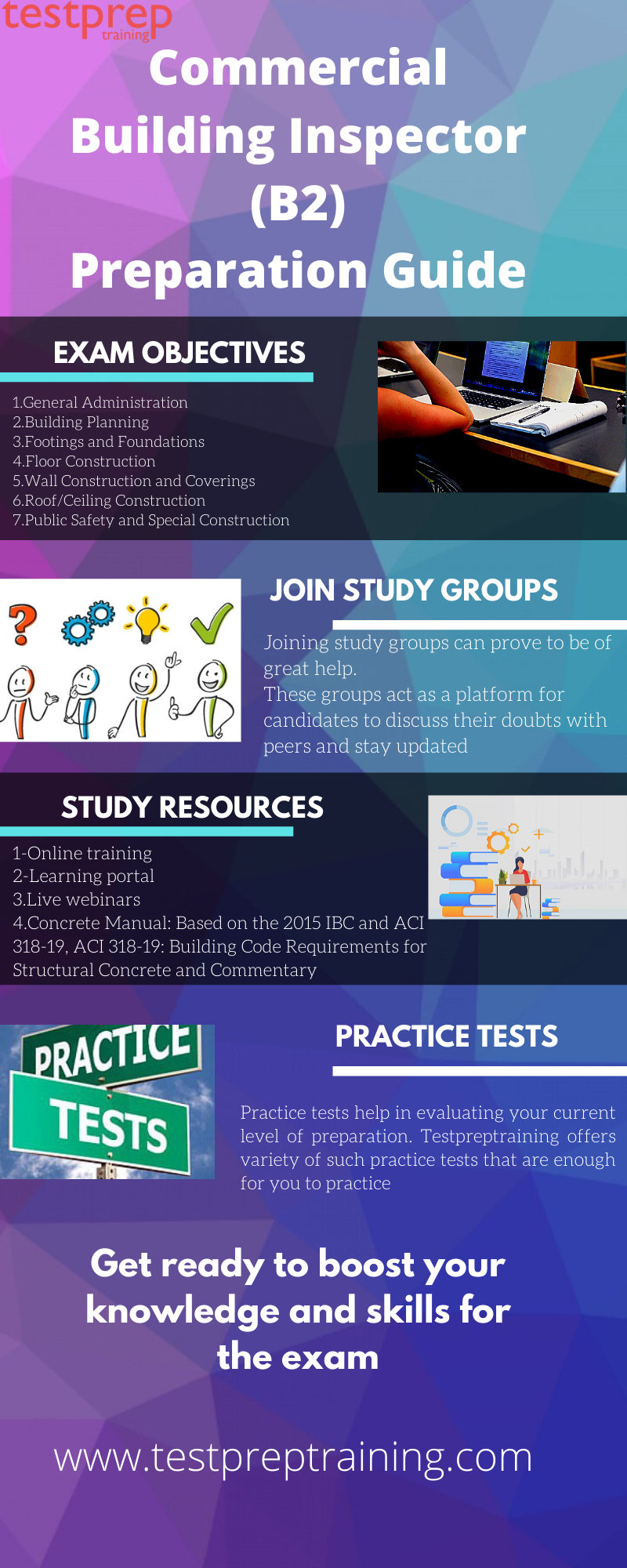Commercial Building Inspector (B2)

The Commercial Building Inspector (B2) exam offered by ICC is a highly recognized national-level certification exam. A Commercial Building Inspector is liable for performing inspections of structures so as to work out compliance with the different Building Codes and Standards adopted by his / her jurisdiction. Besides, the Inspector shall be ready to inspect commercial structures of any size or occupancy at this level of certification.
Scheduling/Rescheduling the exam
In order to schedule your exam. Follow the given steps:
- Login to myICC
- Use your legal first and last name
- Purchase the exam
- Pay for the exam first before you can schedule it
Keep the following in mind:
- Within six-months period, you can attempt the exam six-times
- After attempting the exam six-times, wait for six months from the first attempt to register again
Exam Details
Before jumping into preparation, you should be familiar with all the necessary details regarding the exam. This helps you retain updates and hence gives a clear vision of how to proceed with the preparation in accordance with the sort of questions asked and the time duration. So, we have compiled such important details of the Commercial Building Inspector (B2) exam below:
- Type of questions : Multiple-choice questions
- No. of questions : 80
- Time allotted : 3:30 hours
- Exam type : Open book
- Level : National certification
For more details and any queries, visit the Commercial Building Inspector (B2) Exam FAQs
Commercial Building Inspector (B2) Course Outline
The syllabus for this exam has the following sections and subsections:
Domain 1: General Administration 6%
Project Administration 1%
- Verify that project information is provided and is adequate. Validate that the project is designed by approved persons when required, and has required approvals. Verify that products not detailed in the building code are approved by the building official and installed according to their listing. Verify that the required approved plans and specifications are available when required and retained by the building official for the period required.
Public Information and Legal 1%
- For new and existing structures, answer questions about the need for permits and inspections, including special inspections and structural observations, general code compliance of designs, procedures, and materials. Communicate, issue, and maintain inspection reports, correction notices, stop-work orders, and data for the issuance of the certificate of occupancy.
Plan Reading 4%
- Read plans to verify the project conforms with the code, approved plans, and construction documents.
Domain 2: Building Planning 20%
Fire Resistance-Rated Construction 5%
- Inspect fire-resistance-rated construction for compliance with the code and tested assembly requirements.
Building Location 2%
- Inspect the construction site to see that the building or structure location is in compliance with the requirements of the local ordinances, fire separation regulations, fire access, and the approved site plan. Verify that final grade will provide the required slope away from the footing or foundation wall. Verify finish floor elevation in flood-hazard areas for compliance with local and federal requirements.
Interior-Environment 1%
- Verify that the actual and allowable floor area calculations are correct. Inspect for compliance of minimum room dimensions and openings. Verify compliance of lighting and ventilation systems.
Occupancy Classification and Type of Construction 5%
- Verify or determine the occupancy classification, provisions for special uses, and type of construction requirements, including individual elements or components.
Safeguards During Construction 1%
- Assure that there are proper precautions at the construction site.
Accessibility 2%
- Inspect buildings to assure elements are accessible and usable by individuals with physical disabilities as specified by the code, approved plans, and construction documents.
Material Quality 2%
- Inspect that materials are in compliance with the markings, standards, and the materials’ characteristics.
Interior Coverings 2%
- Verify that floor, wall, and ceiling coverings are correct types and thicknesses and have correct support.
Domain 3: Footings and Foundations 8%
Footings 3%
- Verify that the building site’s soil load-bearing capacity and stability complies with approved plans or reports. Verify that footings are laid out with correct depth, size, and setbacks, and that footings extend below the frost line. Inspect below-grade work for compliance with the code.
Stepped Footings and Special Foundations 1%
- Verify that stepped footings and specialized foundations are constructed per the approved plans or code.
Piles and Piers 1%
- Verify that piles and piers have correct support and anchor, and that wood members have protection against insects and decay.
Foundation Walls 3%
- Verify that foundation stem walls are correctly sized and have sufficient height above grade. Justify that foundation wall reinforcement, anchor bolts, and fasteners are correct type, size, and grade and are placed per approved plans. Verify that foundation dampproofing and waterproofing is installed where required. Justify maximum unbalanced fill height. Verify that foundation walls are properly braced prior to back fill.
Domain 4: Floor Construction 8%
Floor Systems 5%
- Inspect floor system spans, bearing, and connections for compliance with approved plans. Verify that the cutting, notching, and borings are within the limitations permitted by code, and that materials are protected against insects and decay where required. Justify that subflooring and decking has required thickness, span, and grade and meets installation specifications. Verify compliance of floor design and fasteners. Validate that crawlspaces have required clearance, ventilation, insulation, screening, and access openings.
Concrete Slabs 3%
- Inspect concrete slabs placement for compliance with standards and material characteristics, and that proper precautions are there in adverse weather conditions.
Domain 5: Wall Construction and Coverings 21%
Wood Wall Systems 5%
- Inspect wall systems for proper spans, spacing, bearing, and connections. Verify that preengineered wall systems are in accordance with the approved drawings and manufacturer’s specifications. Verify that the cutting, notching, and borings are within the limitations permit by code, and that wood members have protection against insects and decay where necessary.
Steel Framing Systems 3%
- Inspect wall systems for proper spans, spacing, bearing, and connections. Verify that preengineered wall systems are in accordance with the approved drawings and manufacturer’s specifications. Inspect steel framing for compliance with markings, standards, and the material
Masonry Wall Systems 5%
- Inspect grouting, bonding, mortar type, mortar joint thickness, height, size, lintels, and distance between lateral supports for masonry walls. Verify that weather conditions are suitable for masonry construction and that proper precautions are there for adverse weather conditions.
Concrete Wall Systems 3%
- Inspect height, size, attachments, bracing, and distance between lateral supports. Verify that weather conditions are suitable for construction and that proper precautions are there for adverse weather conditions.
Wall Reinforcement 2%
- Inspect reinforcement for size, length of lap splices, clearances, alignment, cleanouts, and presence of loose rust, oil, or millscale.
Exterior Sheathing and Weather-Resistant Coverings 3%
- Verify that exterior sheathing and weather-resistant siding materials are in correct size, identified, and installed; protected against insects and decay; and have appropriate clearances to finish grade. Verify that exterior veneers and weather-resistive siding have correct anchorage, support, and backing. Justify that a weather-resistant barrier is correctly installed for all walls and around all wall openings. Verify that plaster, stucco, and metal lath have correct thickness and fasteners, and are correctly installed.
Domain 6: Roof/Ceiling Construction 6%
Roof/Ceiling Assemblies 5%
- Inspects roof/ceiling construction for compliance with span, grade, type, connections, bearing, and quality requirements. Verifies that trusses are in accordance with the drawings and properly spaced, braced, and supported. Verify roof access and rooftop structures where required, provision of insulation is of permitted materials where required, and its correctly installed.
- Validate that vapor and moisture barriers are correctly installed. Verify that attic and ceiling area construction has proper ventilation, screens, and access.
Roof Sheathing and Coverings 1%
- Verify correct classification of roof coverings, roof slope, installation, flashings, and details, and method of roof drainage. Inspects roof sheathing for proper thickness, grade, support, and fastening. Verify re-roofing complies with code, design, and installation standards.
Domain 7: Public Safety and Special Construction 31%
Means of Egress 10%
- Verify general means of egress requirements, exit access, exits, and exit discharge, any miscellaneous means of egress and special occupancy requirements. Verify emergency escape and rescue requirements.
Fire Protection Systems 4%
- Inspects both manual and automatic fire protection, fire alarms, and detection and standpipe systems for proper installation, power supply, and locations.
Smoke and Fire Venting Control 4%
- Inspect for smoke control and fire venting as required by the code, approved plans, and construction documents.
Interior Finishes and Insulation 4%
- Verify that interior floor, wall and ceiling finishes, insulation, and foam plastics comply with flame spread and smoke-developed index density requirements. Verify floor finishes comply with the critical flux rating required by the code, approved plans, and construction documents.
Safety Glazing and Glass 4%
- Verify that safety glazing is correctly installed and labeled where required.
Opening Protectives, Penetrations, and Joint Systems 2%
- Inspects opening protectives, penetrations, and joint systems in fire-rated assemblies to assure compliance with the code, approved plans, and construction documents. Verify that fire blocking and draft stopping are provided where required.
Miscellaneous Construction 1%
- Verify that exterior stairs, ramps, porches, decks, and balconies which are open to the weather are constructed to support designed loads; are of suitable materials; and have required slope and width, tread, riser, headroom, guardrails, and handrail dimensions.
Building Services and Special Construction 1%
- Inspect existing structures, membrane structures, temporary structures, pedestrian walkways, tunnels, awnings and canopies, marquees, signs, towers, antennas, elevators, and conveyance systems. Inspect building components for seismic restraint requirements.
Fireplaces and Chimneys 1%
- Verify that fireplaces, flues, and chimneys are correctly designed and have required clearances from combustible construction.
Preparation guide for the Commercial Building Inspector (B2) Exam

Familiarize yourself with the syllabus of exam
First of all, you should familiarize yourself with all the topics and subtopics that are there in the Commercial Building Inspector (B2) exam syllabus. This will help you have a good concept of what you’ll need to learn and how you’ll arrange your study time. Also, remember that putting what you’ve learned into practice is crucial, so keep that in mind while you study. As a result, begin your preparation by properly reviewing the curriculum.
Explore the details of exam
Another thing to think about before you begin is to learn everything you can about the exam’s format, including the type and amount of questions, as well as the time given. This will help you plan your study strategy and manage your time while taking the exam.
Study resources
- You can join online training programs in order to prepare for the exam. ICC offers their virtual training wherein you get to communicate with the instructor remotely.
- You can attend live webinars for topic-wise training and also record online training that you can access from anywhere and anytime so as to learn about topics of your interest.
- Though, if you wish then you can also go for self-study for the exam as well. You can study with these reference books.
- Concrete Manual: Based on the 2015 IBC and ACI 318-19
- ACI 318-19: Building Code Requirements for Structural Concrete and Commentary
Join study groups
Joining study groups and communities can also prove to be of great help. This acts as a platform that connects professionals and beginners which in a way helps you clear all of your queries and also gives you the chance to have healthy discussions with peers from the same background. Hence, joining these groups helps to keep you updated.
Practice tests
- The last and the most important step of preparation is practicing questions. This has dual benefits as it helps you not only evaluate your level of preparation but also helps you boost your confidence by attempting challenging questions.
- The practice tests that Testpreptraining.com offers are definitely reliable and enough to practice in order to ace the exam.
- We provide unique sets of questions that professionals design for you to practice and sweep smoothly.


